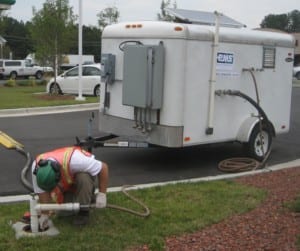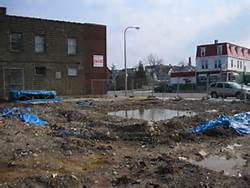 You had a Site Characterization or Environmental Site Assessment completed for your property. Contaminants have been identified and now the regulatory agency has requested a Remedial Action Plan. Two questions we often get are what is a Remedial Action Plan and how much will a remedial action plan cost? In this article we will outline the typical components of a Remedial Action Plan and discuss how site-specific factors—such as the environmental sensitivity of the site, extent of contamination, level of scrutiny by the regulating agency, efficiency of the environmental professional, and client objectives—affect the time, and thus the cost, of a Remedial Action Plan.
You had a Site Characterization or Environmental Site Assessment completed for your property. Contaminants have been identified and now the regulatory agency has requested a Remedial Action Plan. Two questions we often get are what is a Remedial Action Plan and how much will a remedial action plan cost? In this article we will outline the typical components of a Remedial Action Plan and discuss how site-specific factors—such as the environmental sensitivity of the site, extent of contamination, level of scrutiny by the regulating agency, efficiency of the environmental professional, and client objectives—affect the time, and thus the cost, of a Remedial Action Plan.
What is a Remedial Action Plan?
A Remedial Action Plan (RAP) is a detailed summary of the environmental issues found on a property during a site characterization and outlines a plan of action that illustrates which remedies will be used to achieve cleanup goals. Also included is the plan of implementation and how its effectiveness will be measured. A RAP presents a pre-defined end point to ensure the responsible party, the environmental professional, and the regulating agency are in agreement of the final goal to eliminate the chance of any further contamination at the site.
The RAP is typically organized to contain the following elements, based on the nature, extent, type, volume, or complexity of the release:
- A brief summary of the site characterization report conclusions.
- A copy of the plans relating to worker health and safety, management of wastes generated and quality assurance/quality control procedures, as they relate to the remedial action
- A list of required Federal, State and local permits or approvals to conduct the remedial action.
- A discussion of how the remedial action will attain the selected remediation standard for the site.
- The results of treatability, bench scale or pilot scale studies or other data collected to support the remedial action.
- Design and construction details for the remedial action, including expected effectiveness.
- Operation and maintenance details for the remedial action, including:
- A schedule including initiation and completion dates for all elements of the remedial action plan.
- The expected concentrations and quantities of regulated substances in any discharge.
- The disposition of the discharge.
- A schedule for monitoring, sampling and site inspections.
- A site map showing the location of buildings, roads, property boundaries, remedial equipment locations and other information pertinent to the remedial action.
- A description of the media and parameters to be monitored or sampled during the remedial action.
- A description of the analytical methods to be utilized and an appropriate reference for each.
- A description of the methodology that will be utilized to demonstrate attainment of the selected remediation standard.
- A description of proposed post-remediation care requirements.
How Much Will a Remedial Action Plan Cost?
The cost to prepare a RAP largely depends upon the amount of time it takes to develop the document based on the requirements set forth by the state or Federal regulating agency and the site-specific conditions outlined below.
Environmental Sensitivity of the Site
The time it takes to develop a RAP is dependent upon the environmental sensitivity of the site. For example, if the site is near a water supply well, the proposed remedy will require a much more aggressive design than a site that is not near any sensitive receptors.
Extent of Contamination
The size of the contaminant plume can have a large influence on the time it takes to complete the RAP. For example, a large contaminant plume might require more than one treatment system and multiple designs for specific areas. On the other hand, a small contaminant plume may be able to be addressed with a simple remedy that requires very little design.
Level of Scrutiny by Regulating Agency
There are different requirements for each state regarding the RAP review and approval process—some states have very detailed and specific outlines that must be followed, and some have minimal requirements. Likewise, some states charge a fee to review a RAP and some do not. In New York, for example, there is usually no cost to have the RAP reviewed by the regulating agency (the New York State Department of Environmental Conservation). However, fees in other states can be charged to the responsible party by the regulatory agency for the review process. If the RAP does not conform to the expected specifications of the agency, it may be rejected and sent back for rewrites.
Efficiency and Experience of the Environmental Professional
Using a company with a great deal of experience in RAP development will save time and money. The average amount of time needed to complete a RAP ranges from 40-80 hours. Experienced companies often have templates from previously-completed RAPs that can be adapted to fit specific projects, eliminating the need to begin from scratch.
Experienced companies are knowledgeable of the level of detail the regulatory agency looks for in a RAP, mitigating the need for re-writes.
Client Objectives
Clients may have their own objectives for selecting a remedial approach that require design modifications. For example, if a property sale is contingent upon quickly meeting cleanup goals, a more aggressive approach may be required and the RAP may have to contain additional design specifications. Conversely, if the client does not have time constraints, they may choose to employ a less aggressive remedial method that does not require detailed design specification—subject to meeting regulatory guidance objectives, of course.
There are many different factors that affect the cost to prepare a Remedial Action Plan. At Ambipar Response EMS, Inc., we use our experience to provide customers with the most efficient solutions to their environmental concerns. We have developed RAPs ranging in cost for as low as $4,000 for smaller sites, and for as high as $35,000 for large chemical spills. Our staff of environmental professionals has produced hundreds of RAPs with the ultimate goal of achieving a resolution to regulatory agency oversight, and meeting cleanup objectives. If you have any questions regarding the development of a Remedial Action Plan for your site, please feel free to contact us.
For more information about Phase I and Phase II Environmental Site Assessments, check out the links below:


